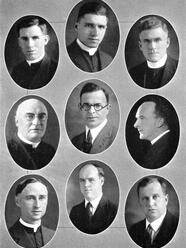
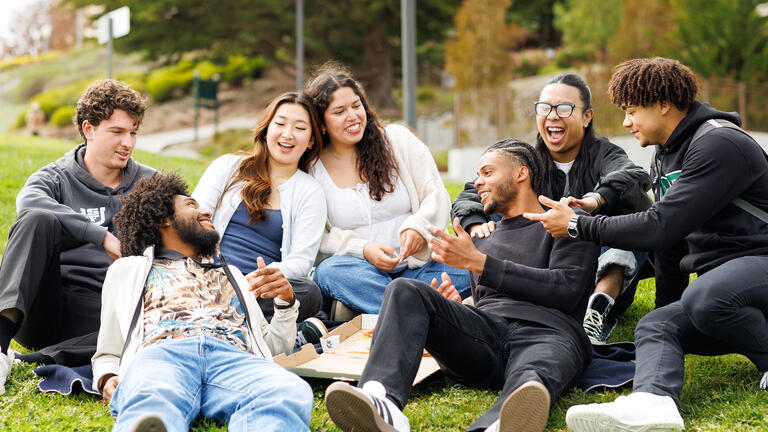
College of Arts and Sciences
Our History
Origins (1540-1924)
The Society of Jesus (Jesuits) was founded in 1540 by Ignatius of Loyola, eventually creating the largest global network of educational institutions. In California, Spanish colonization beginning in 1769 devastated Indigenous populations, and by 1776, Spanish missions like Mission Dolores were established on Ramaytush Ohlone land. Following the 1848 Gold Rush, San Francisco’s population surged, setting the stage for the founding of St. Ignatius Academy in 1855 by Jesuit priest Antonio Maraschi, S.J., with just three students and three faculty members. In 1858, the college published its first curriculum, offering subjects like rhetoric, composition, and modern languages — foundations of today’s College of Arts and Sciences. As enrollment and programs grew, the school relocated several times — from its original location to Market Street in 1862, then to Van Ness Avenue in 1880, where it featured scientific laboratories and a large library — until both the college and church were destroyed in the 1906 earthquake and fire. Temporarily housed in a makeshift “Shirt Factory” building, the college weathered further challenges during World War I and the 1918 flu pandemic, ultimately surviving a major financial crisis through a successful fundraising campaign completed by 1925.
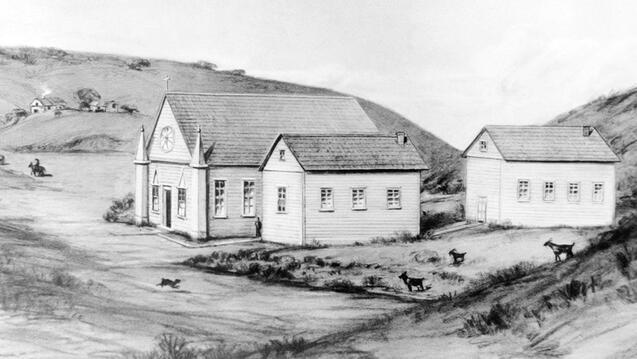
1855
St. Ignatius Academy founded in San Francisco by Anthonio Maraschi, S.J., an immigrant Italian priest who studied at Georgetown College before being sent to San Francisco. St. Ignatius Academy opened its doors on October 15, 1855, and three students attended the first day. There were three faculty members to meet them, resulting in a perfect 1:1 ratio of faculty to students.
1858
St. Ignatius College publishes its first curriculum, including precursors of subjects taught in the College of Arts and Sciences in 1925 and today, such as rhetoric, composition, mathematics, modern languages, history, music, and art.
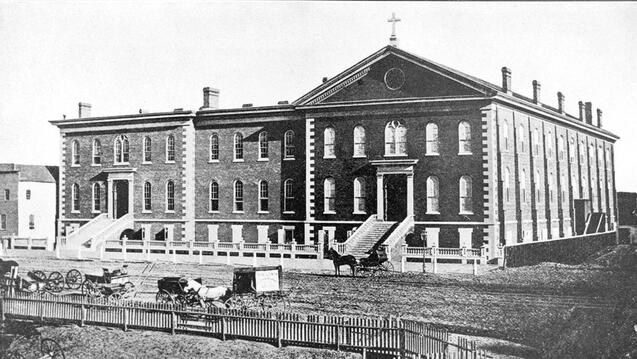
1862
St. Ignatius College moves a to new building on Market Street, between Fourth and Fifth Streets, the current location of the San Francisco Shopping Centre.
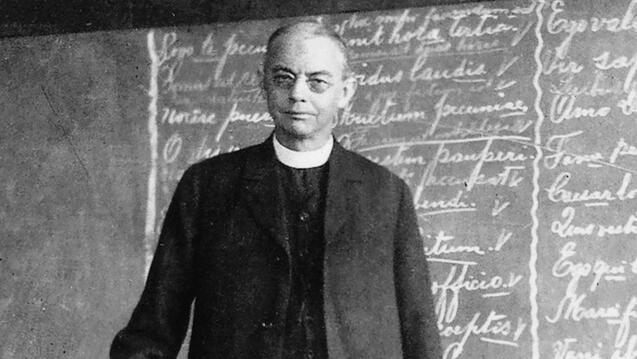
1876
Joseph Neri, S.J., professor of natural sciences at St. Ignatius College, is the first person in the nation to give a public demonstration of the electric light.
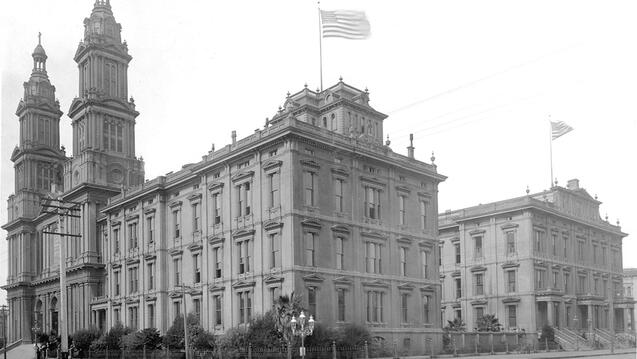
1880
St. Ignatius College and Church move to new buildings on Van Ness Avenue, current site of Davies Symphony Hall. College includes scientific laboratories and a library that contains “the cream of knowledge on all necessary subjects.” By 1900, the college library holds more than 30,000 books and nearly 8,000 journals.

1883
John Montgomery, after earning two science degrees from St. Ignatius College, constructs and flies the world’s first successful glider. He later becomes a college professor at Santa Clara College.
1919
St. Ignatius College faces a debt of more than $1 million and is on the verge of bankruptcy due to unpaid loans associated with rebuilding the college after the 1906 earthquake and fire, decline in enrollment during World War I, and cost overruns associated with building a new church on the corner of Fulton Street and Parker Avenue. The school’s first major fundraising campaign, led by school administrators; prominent alumni; and civic, business, and religious leaders, raises sufficient funds to save the institution and pay off the debt by 1925.
Roaring Twenties - World War II (1925 to 1945)
In 1925, St. Ignatius College formally established the College of Arts and Sciences, offering a rigorous curriculum and enrolling 108 students in its inaugural year, including its first Asian student, Thomas Okuno. The college expanded culturally and artistically with a renowned theater program, culminating in the construction of the Liberal Arts Building in 1927, which housed classrooms, a theater, laboratories, and student spaces — later renamed Campion Hall and eventually Kalmanovitz Hall. During the Great Depression, enrollment dropped, but USF still achieved milestones such as forming one of the first integrated college football teams and officially changing its name from St. Ignatius College to the University of San Francisco in 1930. The campus physically grew with the acquisition of 14 acres of former cemetery land in 1934, where many of today’s main buildings now stand, including the library and science centers. Despite major disruptions during World War II — when enrollment plummeted and military training programs took over campus — USF rebounded in 1945 with a surge of returning veterans, ushering in a new era of growth and development.
1925

The departments of arts, sciences, and philosophy officially integrated to become the College of Arts and Sciences. Required courses include English, Latin, Greek or mathematics, chemistry, public speaking, religion, philosophy, and foreign language. Elective courses include ancient classics, modern language and literature, history, economics, science, law, and commerce and finance.
Hubert Flynn, S.J., (in the left center of the image) was selected as the first dean of the College of Arts and Sciences. He was a long-term faculty member, and a beloved adviser to students and their organizations. Before and after his tenure as dean, Fr. Flynn taught English, classics, religion, and philosophy.

1926
During the fall of 1925, there are 108 students enrolled in the College of Arts and Sciences, out of a total enrollment of 401 at St. Ignatius College. The sophomore class in the College of Arts and Sciences is pictured here in 1926, the year after the college was officially formed. In the front row on the far left is John Barrett, the class president, and in the middle of the front row is John Gearon, S.J., one of the college’s professors.
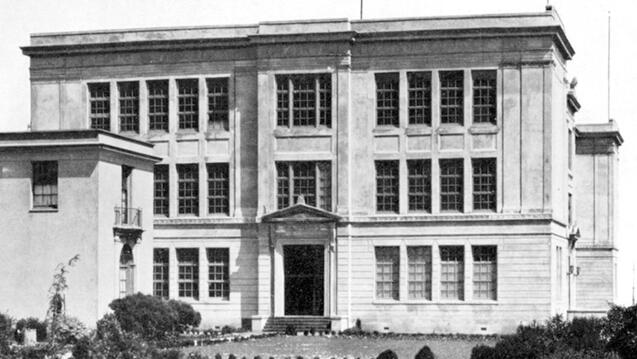
1927
St. Ignatius College moves into the new Liberal Arts Building. It initially housed the faculty and administrators of the College of Arts and Sciences, the College of Commerce and Finance, and the College of Law. It included classrooms and lecture halls, laboratories, a small theater, students’ lounge and chapel, cafeteria, bookstore, athletic equipment store, libraries, students’ lockers, and offices for student government. By 1928, 1,090 college students occupied the building for day and evening classes.
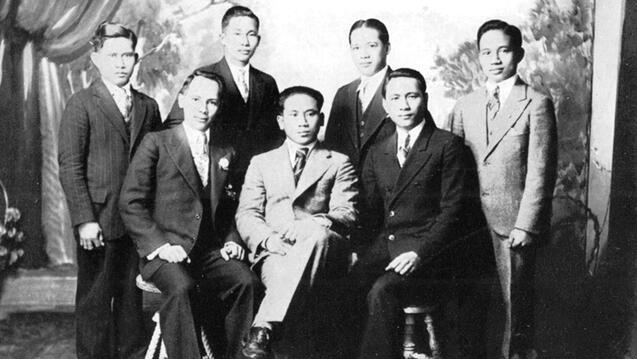
1929
The first ethnic and culturally focused student organization formed in the College of Arts and Sciences. Named the Filipino Ignatians, its purpose was to enable and encourage the members to participate in the activities of the College and to acquaint the new Filipino students with its regulations and customs.

1930
St. Ignatius College celebrated its Diamond Jubilee, the 75th anniversary of its founding in 1855. At the urging of various alumni groups, the institution changed its name to the University of San Francisco.
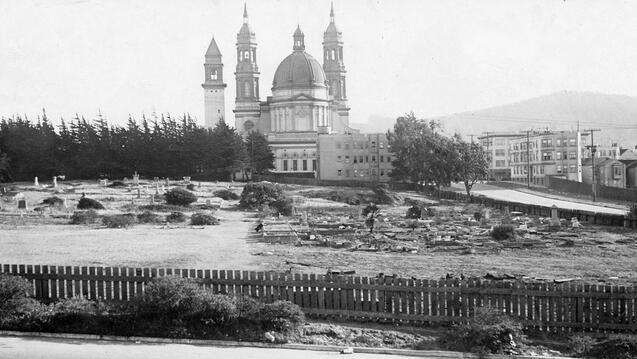
1934
After years of litigation and negotiations, approximately 14 acres of a Masonic Cemetery, situated just north of the Liberal Arts Building and St. Ignatius Church, was purchased by USF. Most of the buildings on USF’s lower campus were built over this cemetery.
1940
While war was raging in Europe and Asia, Raymond Feely, S.J., a College of Arts and Sciences faculty member, published the USF Credo, which later appeared in the USF catalog as the university’s first mission statement. The USF Credo received national publicity and was reprinted in the publications of many other Jesuit institutions. In the document, Fr. Feely outlined what he viewed as basic beliefs in American Democracy and Jesuit education in contrast to the totalitarian political and economic systems around the world. From 1931 to 1939, Fr. Feely taught philosophy, religion, and political science. In 1939, he was selected to be dean of the faculties, a position he held until 1951, when he was appointed USF’s first academic vice president.

1941
United States enters World War II. USF enrollment plummets as students volunteer for the armed forces or are drafted. An Army Specialized Training Program (ASTP) was established at USF for the training of engineers. Eight temporary buildings, including barracks, offices, and an infirmary, were built on campus.
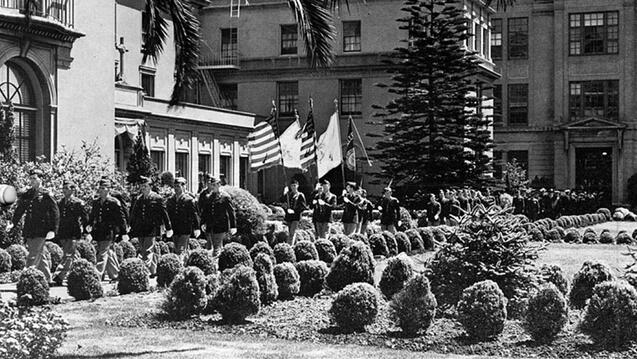
1945
World War II War ends in August 1945. More than 2,700 USF students and alumni served in all branches of the armed forces, and 106 were killed. Veterans start to return to USF in large numbers under the G.I. Bill of Rights. Enrollment soars in the College of Arts and Sciences and in all USF programs. By the fall semester of 1945, because of the first wave of returning veterans, student enrollment had jumped to 762, a 137% increase. One hundred thirty-eight of the new students attended USF under the G.I. Bill of Rights.
Postwar Years (1946-1960)
In the years following World War II, USF saw significant expansion, beginning with the leadership of Alexis Mei, S.J., as postwar dean of the College of Sciences and later the College of Arts and Sciences, and the launch of a major campus building campaign under President William Dunne, S.J. The College of Arts and Sciences attracted remarkable faculty like Arthur Furst, a global authority in toxicology, and welcomed future leaders such as Pierre Salinger and Arthur Dugoni among its graduates. By 1948, USF had over 3,000 students, with new academic offerings, a growing faculty, and increasing diversity among the student body. The College played a central role in shaping USF’s national reputation through achievements in politics, science, and athletics — most notably the integrated 1951 football team and the championship-winning basketball teams of 1955 and 1956 led by Bill Russell. USF marked its centennial in 1955 with major celebrations, the opening of its first residence hall, and later, in 1958, the dedication of the War Memorial Gymnasium to honor those in the USF community who gave their lives in service.
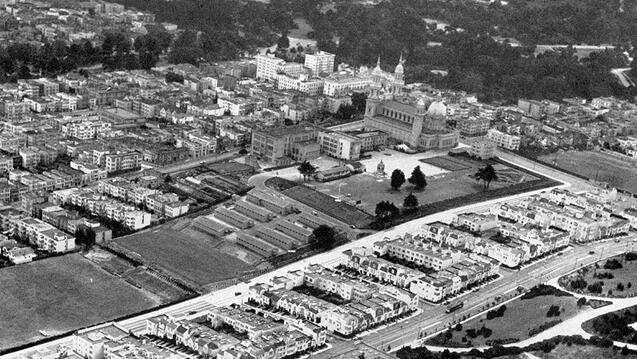
1946
USF President William Dunne, S.J., established the university’s first Board of Regents to help raise money for the construction of a new wing for the Liberal Arts Building, a library, a faculty residence, a memorial gymnasium, a law building, a building for the business college, a science building, a student union, a residence for undergraduate students, and various student scholarship endowments. This photo depicts USF in 1946, including eight barracks from the war used to accommodate the burgeoning student population.
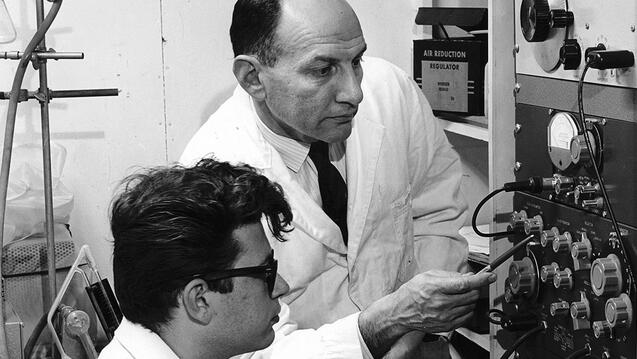
1947
Arthur Furst (standing in this photo) was one of the most prominent professors in USF history. He taught chemistry from 1947 to 1981. He published more than 300 scholarly articles and three books, held offices in several professional societies, won numerous teaching and research awards, founded the USF Institute for Chemical Biology, secured millions of dollars in federal grants, and became the world’s foremost authority on toxicology.
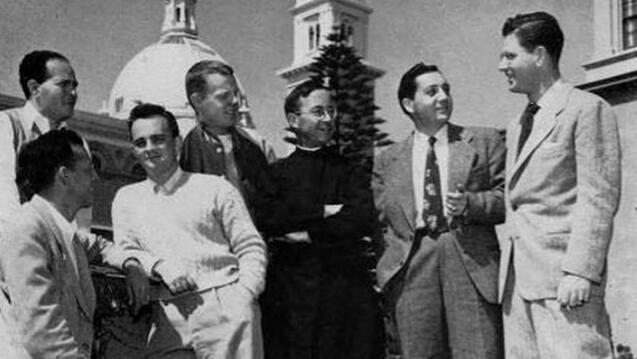
1948
By the fall of 1948, 3,044 students were enrolled at USF, of whom 1,062 were in the College of Arts and Sciences. In the liberal arts in 1948, a student could major in English, French, German, Greek, Italian, Latin, Portuguese, Spanish, classical languages, economics, philosophy, history, or political science. In the sciences, students could major in biology, chemistry, mathematics, and physics.
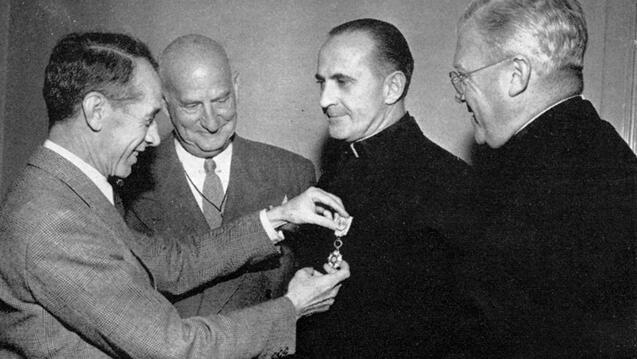
1949
P. Carlos Rossi, S.J., USF professor of languages from 1940 to 1975, helped build the modern languages department in the College of Arts and Sciences during the postwar years. In 1949, he was awarded the Order of the Southern Cross for furthering cultural relations between Brazil and the United States.
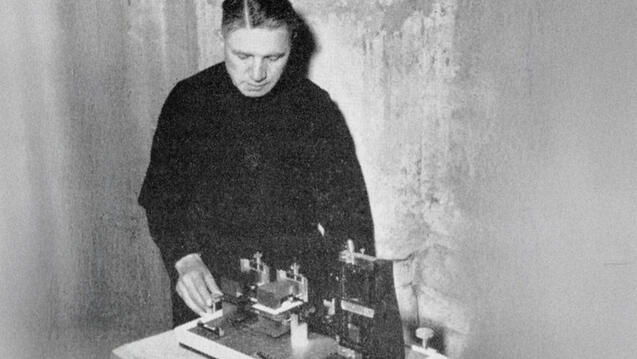
1950
Alexis Mei, S.J., the first postwar dean of the College of Sciences, taught physics, and was a recognized authority on seismology. In 1950, he was appointed dean of the College of Arts and Sciences.
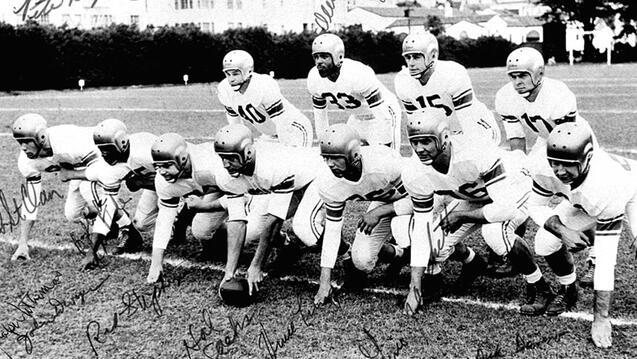
1951
The USF football team of 1951 was undefeated on the gridiron and had nine of its players drafted by the National Football League. Despite fielding probably the best collegiate football team of all time, the Dons were not invited to play in any post-season bowl games unless they left their Black players (Ollie Matson and Burl Toler) at home. The team refused, stood on principle, and transcended the segregated and racist temper of the times.
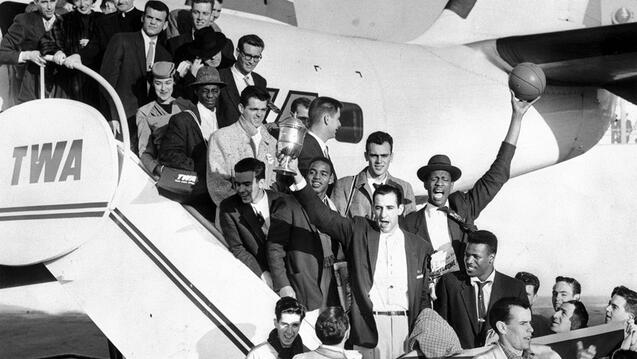
1955
The USF men’s basketball team won two consecutive Division I national basketball championships, powered by the first intercollegiate Division I team to have three Black players (Bill Russell, K.C. Jones, and Hal Perry, all students of the College of Arts and Sciences) as starters. Pictured, the 1954-55 Dons exiting their flight with championship trophy in hand. The legendary Bill Russell holds the basketball.
1958
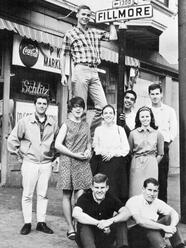
Faculty members who began their careers in the College of Arts and Sciences during the 1950s included Ralph Lane, who started teaching in the sociology department in 1958, and retired 30 years later as an emeritus professor of sociology. Among professor Lane’s many accomplishments was his work in helping to create the Students Western Addition Project (SWAP) in 1962. By 1968, SWAP had become the largest student organization on campus, with approximately 250 members. The students’ goal was to serve underserved groups in the Western Addition of San Francisco, including providing special education and tutorial programs for children in local schools, recreational activities for families, and assistance to senior citizens. Pictured below is the 1968 SWAP steering committee. Sitting on the curb (left to right) are Bob Downey and Neil MacIntyre. The six students standing directly behind Downey and MacIntyre are (left to right) John Howe, Mary Spohn, Leanna Burke, Charlie Martinez, Margie Ryan, and Bob Giddings. Standing in back (with his hand on the Fillmore Street sign) is Chuck Riffle.
From Protest to Progress (1961-1989)
From the late 1950s through the 1980s, the University of San Francisco's College of Arts and Sciences experienced major academic and social developments. The 1960s saw faculty drive student engagement projects like SWAP and the founding of organizations supporting social justice, with the college becoming fully coeducational in 1964 and women quickly distinguishing themselves academically. In the late 1960s and 1970s, the college expanded its curriculum — including early offerings in computer science and ethnic studies — and adapted to enrollment challenges following the postwar baby boom. Faculty achieved national recognition for research and teaching, and USF students and faculty were active in significant social movements, such as civil rights and antiwar campaigns. The 1970s and 1980s brought further growth with the acquisition of the Lone Mountain campus, the establishment of influential academic institutes and centers (like the Center for the Pacific Rim), advances in faculty governance, and ongoing improvements to facilities and graduate programming, all reflecting the university's commitment to diversity and innovation.
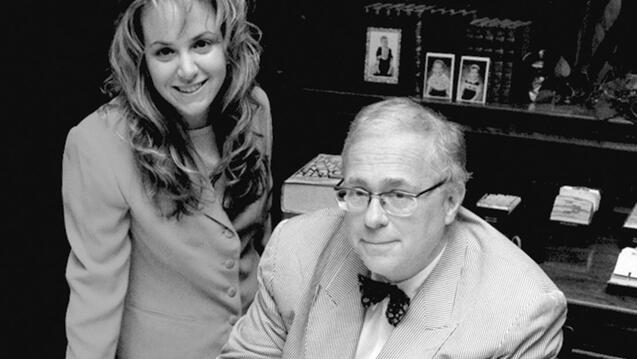
1962
Kevin Starr earned his bachelor’s degree from the College of Arts and Sciences in 1962. He was editor of the Foghorn when it won a Pacemaker Award as the best college publication in the nation. He later earned a PhD from Harvard University and started as a professor in the communication arts department at USF.
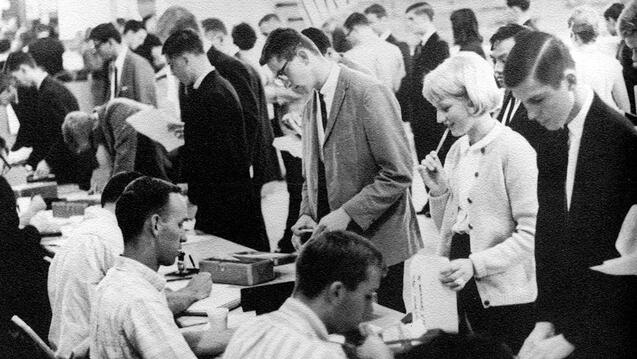
1964
USF became fully coeducational in all divisions in 1964, and 28% of the student body were women in the fall of that year, out of a total enrollment of 4,724. USF’s overall enrollment increased by almost 20% from 1964 to 1965, largely due to the increase in women in the student body. The first female law and business students attended classes in the evening in 1927, but women were not permitted in the day division until 1964.

1965
The Harney Science Center, made possible by a gift from Pauline and Charles Harney (a former USF Regent), was one of the many USF buildings completed during the presidency of Charles Dullea, S.J., from 1963 to 1969. In this 1965 photo, members of the construction crew are reviewing blueprints for the building, which soon housed badly needed science laboratories, classrooms, and faculty and administrative offices.
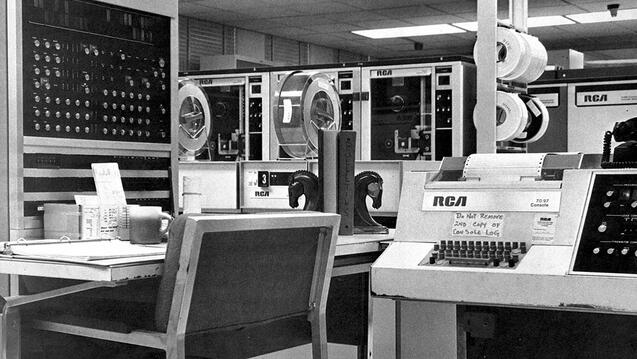
1966
The College of Arts and Sciences began to offer a bachelor’s degree in computer science, and four years later, 10 USF students were among the first in the United States to be awarded a B.S. degree in computer science. By 1970, USF had also installed a mainframe computer, the RCA Spectra/70. It was one of the first computers at a West Coast university. Students used the computer for various projects, including assisting the San Francisco School Board to reassign public school students to reduce school segregation.
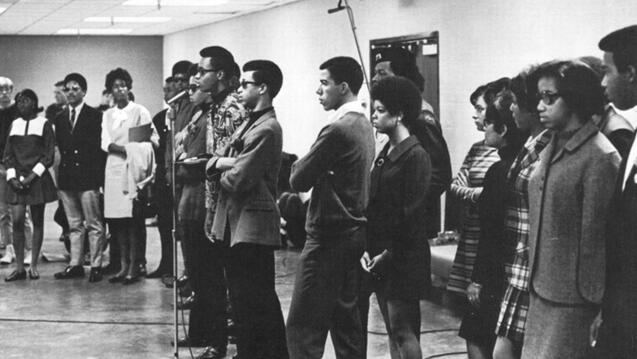
1968
The 1960s was punctuated by political assassinations, civil rights struggles, and the Vietnam War that led to demonstrations and death at home and abroad. A small number of USF students traveled to the South to help register Black voters. In 1968, the Black Student Union (BSU) was formed. The 1969 USF Don Yearbook reported that with the founding of the Black Student Union, “blacks at USF laid the groundwork for the development, at the Hilltop, of a new program of social awareness.”
1969
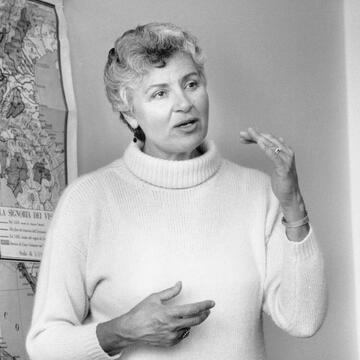
By 1969, the postwar baby boom that had buttressed college enrollments during the 1960s was coming to an end. Like many higher education institutions throughout the nation, the University of San Francisco witnessed a significant enrollment decline from 1969 to 1979. During this period, student activism intensified significantly. In 1969, a group of USF students boycotted a local Safeway market and traveled by bus to Delano, California, the headquarters of the United Farm Workers (UFW), to demonstrate their support for Cesar Chavez and migrant farm workers, who faced terrible employment and living conditions in California’s farming industry. In response to the Vietnam War, about 25 students publicly burned their draft cards, and a fledgling resistance movement was begun by a small student group called the Radical Student Union. Still, the College of Arts and Sciences had 15 departments offering curricula leading to a bachelor’s degree. In the arts, these included communication arts, economics, English, government, history, languages, philosophy, psychology, sociology, and theology. In the sciences, the departments were biology, chemistry, computer science, mathematics, and physics.
Beginning in 1969, Elisabeth Gleason (pictured) taught history at USF for 28 years, published numerous books and articles, served as president of the American Society for Reformation Research, received the Distinguished Research Award from the University of San Francisco and the USF Faculty Association, and was the first recipient of USF’s Sarlo Prize, recognizing teaching excellence that exemplifies the ethical principles underlying the university’s vision, mission, and values.
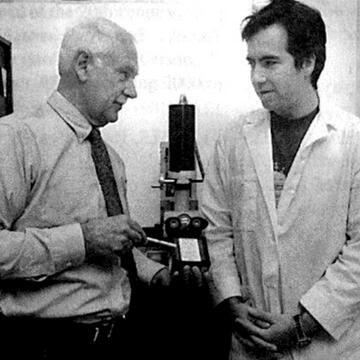
In the same year, Eugene Benton began his career in the College of Arts and Sciences. Professor Benton became internationally known for his pioneering experiments on the detection of radiation in outer space and from earth-bound particle accelerators. Beginning in the 1970s, his experimental devices were on every manned and unmanned NASA mission, including on the Apollo series spacecraft. From 1986 to 2001, he also led joint U.S.–Russian experiments on the effects of long-term space radiation on humans aboard the Russian space station Mir. In 1998, Benton provided NASA with detectors to monitor the crew’s exposure to radiation on the flight of the Space Shuttle Discovery, a crew which included Senator John Glenn.
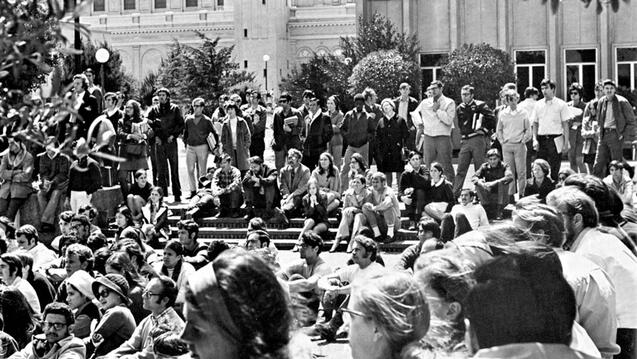
1970
Beginning in the spring of 1969, a weekly open-air microphone was set up in Harney Plaza for students who wanted to speak about the Vietnam War, race relations, or any other issue. In May 1970, the United States “incursion” into Cambodia during Vietnam War precipitated a large outdoor assembly of USF students to hear speakers denounce the war. The Vietnam War ended in 1975, and in its wake, the nation and its colleges and universities faced enormous inflationary pressures.
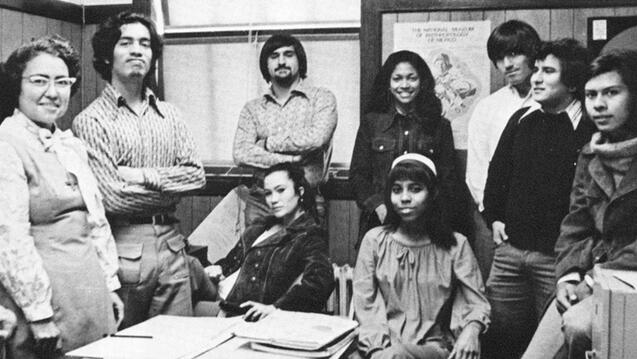
1974
The World English Center (WEC) began in 1974 under John Teeling, S.J., and in 1983, Edward Justen, S.J., became the director. The center was designed to enhance the English-language skills of international students prior to admittance to USF. During the 1970's, USF saw an increase in the number of ethnic minority students on campus, a fact reflected in the growth of student organizations, such as La Raza, pictured here.
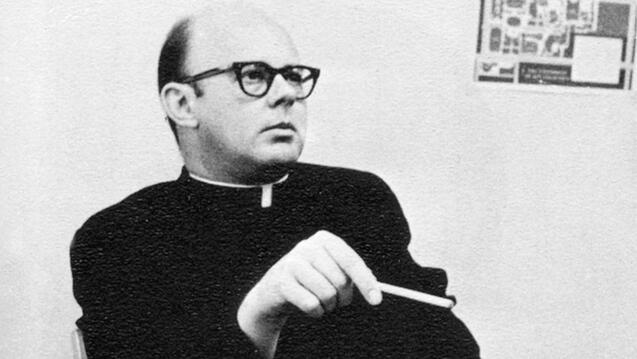
1975
Edward Stackpoole, S.J., an Oxford graduate and associate professor of English at USF since 1961, became the new dean of the college (pictured). Fr. Stackpoole served as dean for five years, was assistant vice president for academic affairs for one year, became rector of the Jesuit Community at USF, taught in the master’s degree program in writing in the College of Arts and Sciences, and retired as professor emeritus of English in 1999.
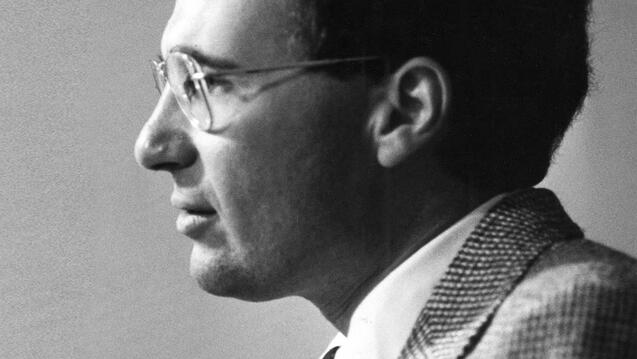
1975
On October 2, 1975, the NLRB certified the USF Faculty Association to represent all full-time faculty members (excluding law school faculty) and all non-administrative full-time professional librarians for purposes of collective bargaining. A new era dawned in the development of faculty and administration relations at USF. Michael Lehmann was the founding president of the USF Faculty Association.
1977
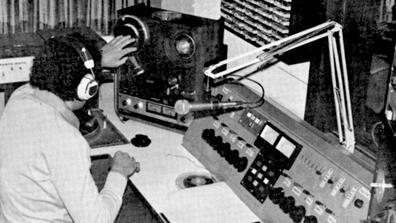
KUSF 90.3 FM broadcast its first show on April 25, 1977, from the station on the ground floor of Phelan Hall (now Burl Toler Hall). In 1970, Steve Runyon, an undergraduate economics major at USF, was selected as the student general manager of KUSF-AM, which was a campus-limited AM station. As general manager of KUSF-AM, Runyon obtained an FM frequency to reach all of San Francisco. From its inception, KUSF-FM served as a training ground for students interested in broadcasting, providing them with a laboratory, work experience, and connections to academic departments at USF, such as media studies. Many USF students who volunteered at KUSF went on to careers in radio broadcasting, television, media relations, and the recording industry. For more than 27 years, KUSF’s “Podium Series” broadcast presentations and lectures by prominent national and international figures. The station also carried a wide range of music, cultural, and social justice programs. The nationally and internationally known and award-winning station went online in 2011 and can be found at kusf.org.
1988
The College of Arts and Sciences witnessed the development of several special institutes and programs during the 1970s and 1980s that continue to enrich the university community. These programs include the Judaic Studies Program, funded by Melvin Swig in 1977; the St. Ignatius Institute, founded in 1976 by Joseph Fessio, S.J.; the Davies Forum, organized by arts and sciences administrators and faculty, and endowed by Louise M. Davies; and the Center for the Pacific Rim. In 1987, USF President John Lo Schiavo, S.J., spearheaded efforts to develop a Center for the Pacific Rim.
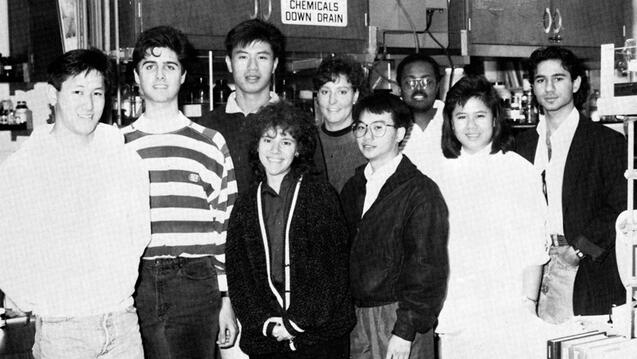
1989
The growth in student diversity during the 1980s at USF is reflected in the 1989 Chemical Society in the College of Arts and Sciences (shown here). From left to right, the students are Makoto Takahashi, Joe Leonetti, Ronald Limsin, Regina Matamoros, Stephanie Grzybicki, Luong Truong, Samson Berhane, Natalie Limson, and Ramsey Deeik.
A Bridge to Today (1990-2025)
From 1990 to 2025, the University of San Francisco’s College of Arts and Sciences experienced substantial growth in student enrollment, faculty, and academic programs, marked by a near doubling of enrollment and the addition of new majors, institutes, and centers. The period was defined by notable leadership — such as Stanley Nel and Jennifer Turpin — who championed diversity, new curricula, and global engagement, while the faculty and students earned national awards and conducted impactful research and public service. Facilities were modernized and expanded, including new academic buildings, the acquisition of properties for science and health education, and the founding of the USF Honors College and research centers, all supported by transformative gifts from alumni and donors. The college responded to contemporary challenges, such as the COVID-19 pandemic, by pioneering online learning and launching innovative interdisciplinary programs like engineering, while also furthering initiatives in public service and social justice. Recent achievements include expanding opportunities for historically marginalized students, winning national debate championships, and ensuring Jesuit values and arts education continue to flourish through new leadership and philanthropic support.
1990
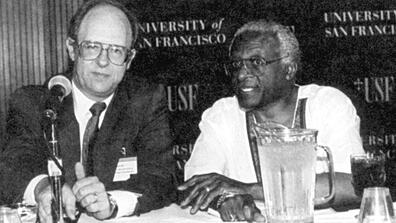
Stanley Nel, shown in this photo (on the left) served as dean of the College of Arts and Sciences from 1990 to 2003, a period of significant growth in student enrollment, faculty recruitment, and program development in the college. Here he is introducing fellow South African and Nobel Peace Laureate Desmond Tutu, Anglican Archbishop of Cape Town, who keynoted an Interfaith Conference for Youth held in June 1995 at USF, part of the United Nations 50th anniversary celebration. In 2003, Nel was appointed USF’s first vice president for international relations.
1991

Deneb Karentz, professor of biology and environmental science, began her USF career in 1991. Her research has been so significant in understanding the world’s southernmost continent that in 2007, the U.S. Board of Geographic Names designated a lake in her honor. Dr. Karentz’s research focuses on the ultraviolet photobiology of marine organisms, and it includes identifying strategies for protection from UV exposure and understanding mechanisms for the repair of UV-induced DNA damage. Her research has been critical in evaluating the ecological implications of ozone depletion in Antarctica, where she has conducted research for more than 30 years. Professor Karentz served as an advisor to the U.S. government delegation to the Antarctic Treaty Meetings.
2001
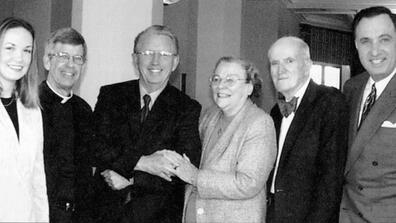
The Leo T. McCarthy Center for Public Service and the Common Good was established in the College of Arts and Sciences. The center serves as a catalyst for campus-wide discussions about social justice issues, policy analysis, voter registration, and scholarly research. Designed for USF students from a variety of academic programs who are interested in service to the community, it combines direct social experience, coursework consistent with students’ public service interests, and special programs featuring distinguished public servants. Pictured at a press conference held on November 30, 2001, are (left to right) USF student Liz Holstein (daughter of donors Robert and Loretta Holstein), USF President Stephen Privett, S.J., former Lt. Governor of California Leo T. McCarthy (a USF graduate of the College of Arts and Sciences and a donor to the Center), donors Joan and Ralph Lane (USF sociology professor emeritus), and former San Francisco Mayor Art Agnos.
2002
The College of Arts and Sciences developed many initiatives, including the Center for Latino Studies in the Americas, the Catholic Studies Program, and the Martin-Baro Scholars living learning community, a program sponsored by the James Irvine Foundation and directed by Gerardo Marín, associate provost for the university and professor of psychology.
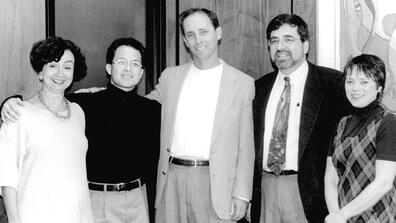
Gerardo Marín is pictured with four other arts and sciences faculty members who served on the governing board of the Center for Latino Studies in the Americas, including (left to right) Esther Madriz, sociology; Eduardo Mendieta, philosophy; Michael Stanfield, history; and Lois Lorentzen, theology.

2003
Jennifer Turpin became the first female dean in the history of the College of Arts and Sciences. While dean, she oversaw the implementation and evaluation of an innovative undergraduate and graduate curriculum and the creation of 23 new graduate and undergraduate degree programs and minors in the college.
2004
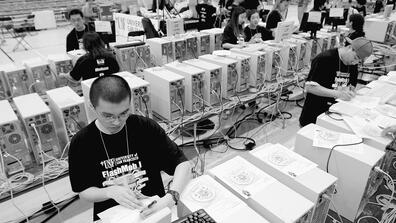
On April 3, 2004, more than 350 students, community volunteers, and faculty members from the computer science department organized the first “flash mob supercomputer” event in history, linking 669 individual computers to a network capable of performing 180 billion mathematical operations per second. A gym inside the Koret Center was transformed into what looked like a computer warehouse, with rows of machines, supplied by volunteers from all over the city. The event was covered by more than 200 media outlets worldwide, including in the New York Times, which described the proceedings in a front-page story. Gregory Benson, USF associate professor of computer science, originated the name “flash mob computing” and first proposed the idea of flash mob computers. Pat Miller, an adjunct computer science professor at USF, helped develop the project as an extension of his class on Do-It-Yourself Supercomputers, and John Witchel, a USF computer science graduate student, turned the project into his master’s thesis.
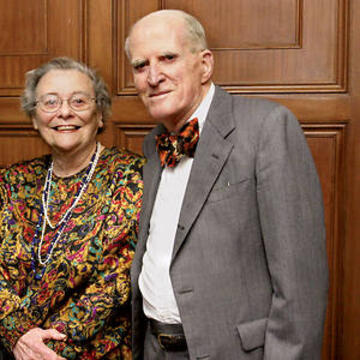
The College of Arts and Sciences received a $1 million gift from Joan and Ralph Lane (pictured here) to endow a center for Catholic social thought at USF. The Joan and Ralph Lane Center for Catholic Studies and Social Thought was initially directed by history professor Paul Murphy and associate director Julia Dowd. In addition to the Lanes’ gift, the Lo Schiavo family agreed that a fully endowed chair, the Joseph and Anna Lo Schiavo Chair, be located within the Lane Center for Catholic Social Thought. With these two gifts, USF focused on the insights of Catholic social thought on contemporary problems to the benefit of the university community and society at large. The gifts significantly enhanced and expanded USF's offerings in the Catholic intellectual tradition. Erin Brigham currently directs the Lane Center, and it is now known as The Joan and Ralph Lane Center for Catholic Social Thought and the Ignatian Tradition.
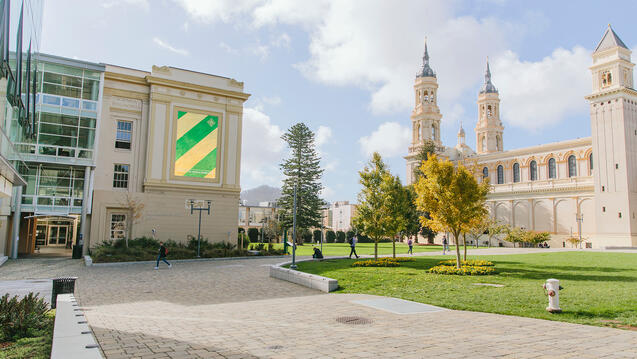
2005
Work began on a $25 million reconstruction of the former Campion Hall, the oldest academic building on campus. The renamed Kalmanovitz Hall, pictured here left of St. Ignatius Church, is named in recognition of a $10 million gift to USF by the Paul and Lydia Kalmanovitz Foundation. Kalmanovitz Hall houses classrooms and faculty offices for the liberal arts and humanities, academic programs, centers, institutes, conference rooms, and lounges.

2012
USF purchased the historic Folger building at 101 Howard Street in downtown San Francisco, a few blocks from where USF was founded in 1855, and where the first arts and sciences classes were conducted. The Downtown Campus now houses a number of College of Arts and Sciences graduate programs including Data Science, Energy Systems Management, Professional Communication, Public Administration, and Sport Management.
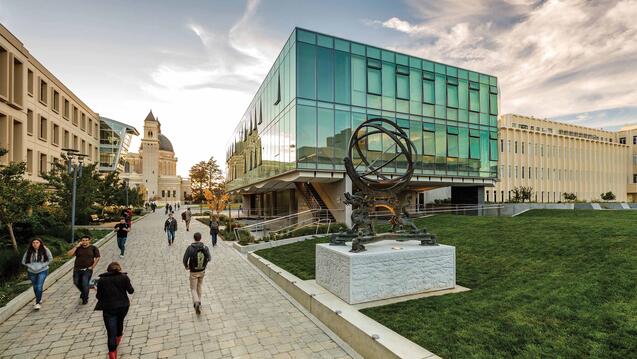
2013
Located in the center of the USF campus, the John Lo Schiavo, S.J. Center for Science and Innovation (the building in the middle) was completed in the summer of 2013. It has 17 teaching labs and classrooms and contains state-of-the-art scientific equipment for use by undergraduate and graduate students.
2017
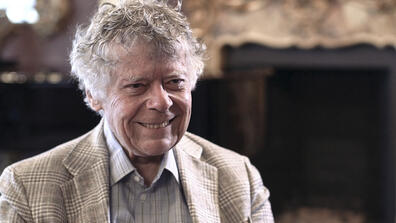
Gordon Getty, who graduated from the College of Arts and Sciences in 1956, pledged $15 million to the university to establish the USF Honors College. Mr. Getty has composed internationally performed operas and other musical works, received numerous musical awards, founded investment companies, and created the Ann and Gordon Getty Foundation, which awards millions of dollars each year to nonprofit organizations. He helped fund numerous USF programs and scholarships, including the Koret Center for Health and Recreation, the John Lo Schiavo, S.J. Center for Science and Innovation, and the USF Honors College.
The Honors College, the first of its kind at a Jesuit university, launched in the fall of 2018 with 400 students, serves as the hub for honors students from all of USF’s programs. It is especially designed to attract top academic students through scholarships, and to expand USF honors students’ studies of the arts, sciences, and humanities. The USF Honors College provides a community of support for students who seek a unique and transformative Jesuit education. Getty’s vision is to bring visiting artists, writers, and scholars to campus to interact with honors students and to foster opportunities for student research, study abroad programs, and mentorships.
2018
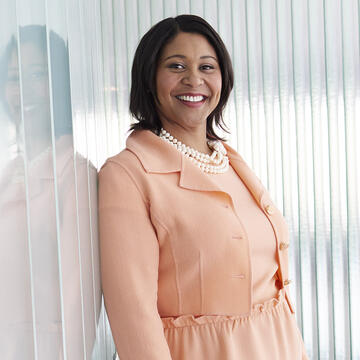
USF’s Black Student Union (BSU) held a 50th anniversary celebration titled “Bending the Arc Toward Justice: 50 Years of Black Student Activism at USF.” The celebration included a panel discussion by BSU members going back 50 years, such as Joe Marshall Jr., graduate of the College of Arts and Sciences, founder of the Street Soldiers National Consortium, and a recipient of the MacArthur Fellowship “Genius” Grant. The celebration also included a dinner featuring San Francisco Mayor London Breed, the first female African American to hold that position. Mayor Breed received her Master of Public Administration from USF.
USF launched the Black Student Success and Engagement Initiative (BASE). The BASE Program provides Black students with a critical sense of belonging; opportunities for engagement in all aspects of university life and in the broader Bay Area community; and the resources, skills, and support necessary to achieve academic excellence and pursue rich and rewarding careers after graduation. BASE includes the Marshall-Riley Living-Learning Community (MRLLC), which allows first-year and sophomore students to live together on campus; share an interest in the historical, intellectual, and political traditions of Black Americans; and engage with the Bay Area Black community through community-engaged learning classes; and the Black resource center. BASE founding co-leads from the College of Arts and Sciences included Pamela Balls Organista, Professor of Psychology and Associate Dean for Social Sciences; Candice Harrison, Associate Professor of History; and Stephanie Sears, Chair and Associate Professor of Sociology.
2020
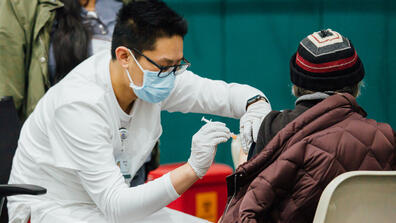
The world-wide COVID-19 pandemic forced the nation’s universities, including USF, and its College of Arts and Sciences, to pivot to online learning, beginning in March of 2020. Face-to-face classes were reconstituted as online courses, residence halls closed, and the campus discontinued most of in-person services and activities.
Fred Angulo, who earned a BS in biology in 1978, and an MS in biology in 1979, both from the College of Arts and Sciences, helped develop a vaccine against the COVID-19 virus that was killing more than 3,000 people a day in the U.S. "It's the greatest thing I've ever done in my scientific career," said Angulo, lead epidemiologist for Pfizer. Angulo, an expert on infectious diseases. In 2018, he joined Pfizer to work on vaccines and vaccine-preventable diseases. The group Angulo worked with at Pfizer provided evidence to U.S. advisory committees that gave recommendations on who should get the vaccine, as well as consultation on the scope and choice of clinical trials for the vaccine. “USF gave me a solid foundation in the liberal arts and biology and science,” he said. “The foundation of all of this work was my science degrees from USF.” Pictured here, a USF nursing student administers a vaccine to a community member during the COVID-19 pandemic.
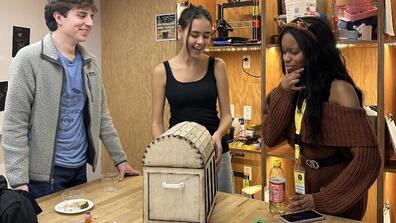
USF's College of Arts and Sciences has launched its first engineering program since 1918, enrolling 30 majors, including 14 women and 17 students of color, in a field where 79% are male. This liberal arts engineering program emphasizes interdisciplinary thinking and is grounded in Jesuit education, focusing on creating a more just world. According to Hana Mori Böttger, the program chair, students are tackling major challenges like hunger and climate change through hands-on projects for four years, preparing them for impactful careers.
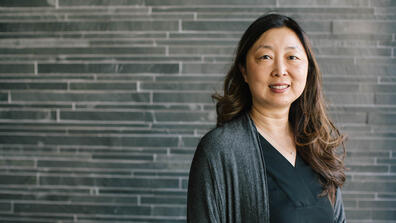
Eileen Chia-Ching Fung is appointed dean of the College of Arts and Sciences. She was awarded a James Irvine Dissertation Fellowship in 1997 and joined the USF English department as a full-time faculty member in 1998. Dr. Fung served as chair of the English department, director of the Asian American Pacific Studies Program, and became associate dean of arts and humanities in 2010. She founded the Honors College with a $15 million endowment from Gordon Getty and secured a $1.5 million gift from Richard Blum for the Privett Global Honors Scholars Program. In June 2023, she became interim provost and vice president of academic affairs, with her appointment made permanent on March 6, 2024.
2022
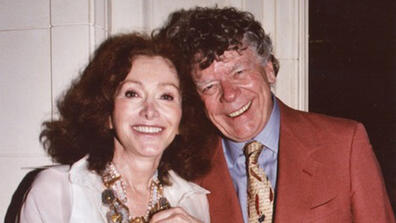
Opportunities for growth spanning the arts and sciences defined 2022, providing the College the space and resources to expand and innovate curricular offerings.
The University of San Francisco received a significant gift from The Ann and Gordon Getty Foundation for the Arts. This funding will enhance arts facilities, support distinguished faculty, and provide access for students. The renovation and expansion will create additional studio and exhibition spaces, transforming the learning and engagement in the arts for USF’s community. This generous contribution honors the memory of Gordon’s late wife, Ann, reflecting their shared passion for the arts and supporting the future of arts education in the Jesuit tradition.
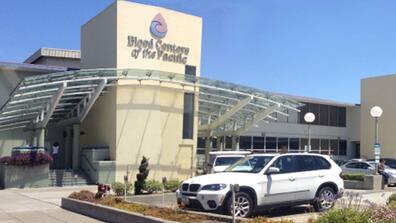
The University of San Francisco purchased the Blood Centers of the Pacific, a building on Masonic Avenue, across from USF’s 281 Masonic Building. The building includes space for labs, classrooms, offices, and meeting rooms for civic engagement. The working name for the site is the Health and Life Sciences Campus. Once the building is fully renovated it will house programs in biology, chemistry, nursing, education, and public health. The new learning environment will allow students to study the impact of social and economic factors on health outcomes in underserved communities. Students and faculty will be able to engage in holistic health research and community-based engagement as part of USF’s Jesuit commitment to whole-person healthcare.
2025
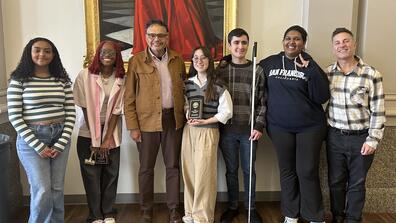
On the 100th anniversary of the St. Ignatius College debate team championship of 1925, the USF debate team, comprised of 15 members, one full-time and one part-time coach, beat debate programs from Claremont, Morehouse, and the University of Vermont, each with three to four full-time coaches, and each with 50 to 70 student competitors. Thirty universities competed in the four-tournament series, culminating in the Social Justice Debates tournament, held at Morehouse College in Atlanta, Georgia. College of Arts and Sciences students Elise Green ’26, and Mecedes Lindsay ’26, teamed up to win the championship. The topic was housing justice, and USF philosophy professor Ronald Sundstrom was chosen as the featured topic scholar for the debate, underpinned by his book Just Shelter: Gentrification, Integration, Race, and Reconstruction. The debate topic was “To achieve housing justice, the United States should focus on the root causes of homelessness rather than provide permanent housing and support services.” The Social Justice Debates are in their ninth year, and this was the first year a school from California had won the tournament. Pictured here, from left to right are Leah Getaneh ’26, Mecedes Lindsay ’26, Ronald Sundstrom, Elise Green ’26, assistant coach Kendrick Lacerda ’24, Nissi Jim Rakesh ’27, and director of debate Robert Boller EdD ’04. This debate achievement underscores one of many historical threads that link the current College of Arts and Sciences to the college’s establishment in 1925, and its debate successes that year. It also reveals a thread stretching back to the first published curriculum of St. Ignatius College in 1858, including a course on elocution.